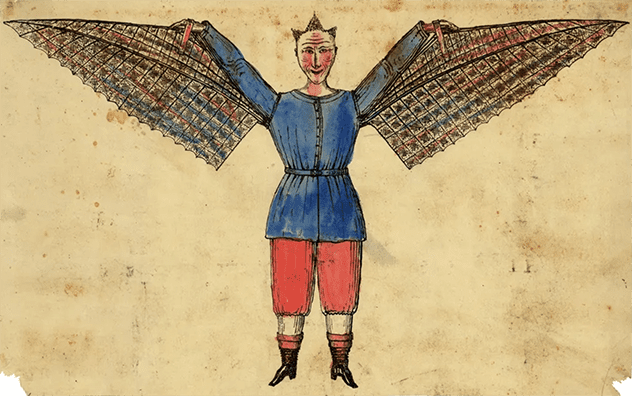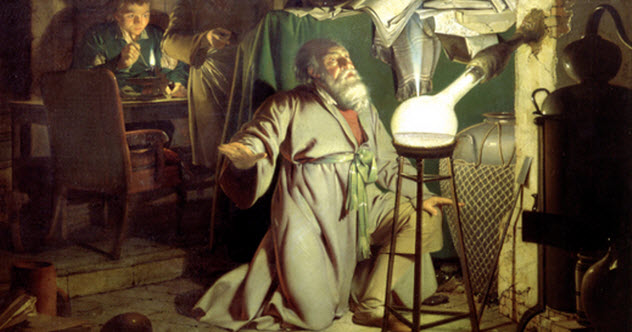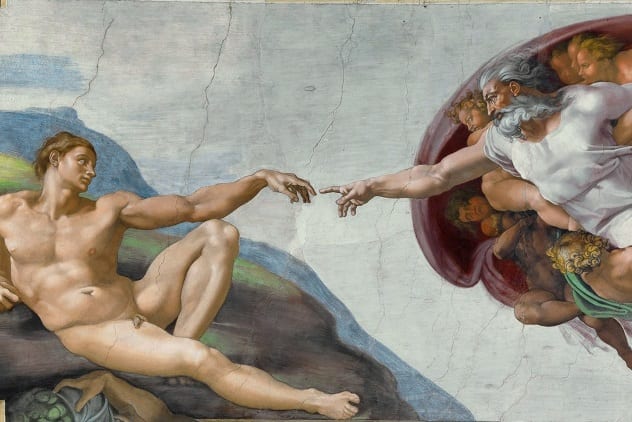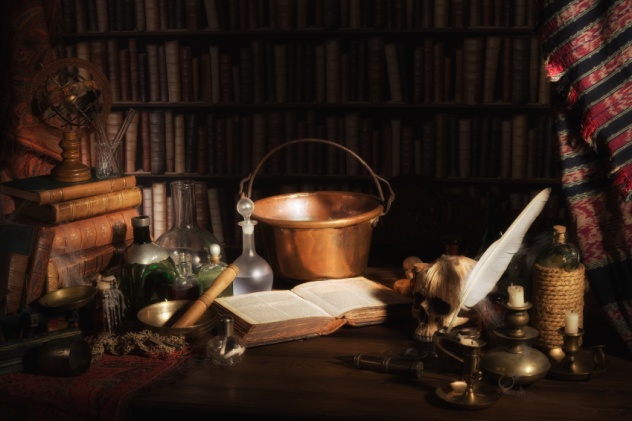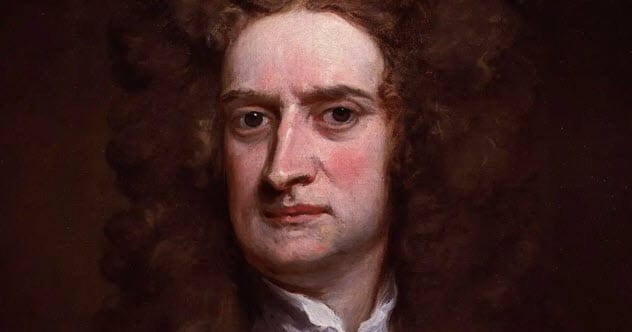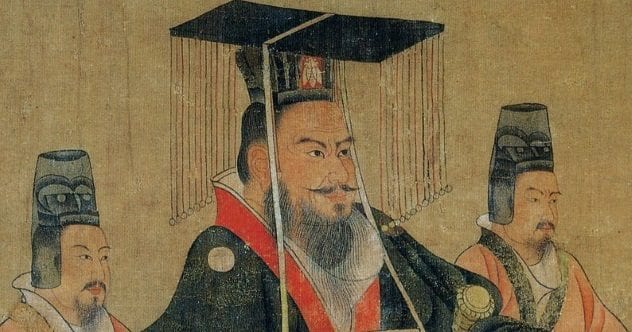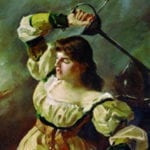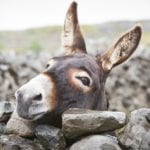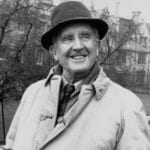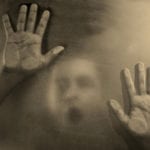Here are ten of the weirdest things about alchemy and alchemists. Top 10 Facts About the Great Beast Aleister Crowley
10 John Damian Flies
Alchemists were some of the greatest thinkers of their age. They wanted to know everything but sometimes their curiosity led them to attempt the impossible. John Damian de Falcuis was an Italian doctor and alchemist who convinced the king of Scotland to fund his research. Huge amounts of alchemical ingredients were provided at vast expense to the crown in hopes that Damian would be able to find a new way of making gold. Unfortunately he failed to do this but he did try to impress the king in other ways. The poet William Dunbar wrote “A Ballad of The False Friar of Tongland, How He Fell in the Mire Flying to Turkey,” which mocked the career and works of John Damian. In particular it recounts Damian’s attempts to fly from the walls of Stirling Castle using a pair of wings he built for himself. Apparently Damian really did manage to fly, for at least a moment. Then he crashed into a pile of muck and broke his leg. Damian managed to explain his failure to fly to the king. “He ascribed the blame to the fact that there were some hen feathers in the wings which yearn for and covet the midden and not the sky.” A bad bird-man blames his feathers.
9 Roger Bacon’s Talking Head
Roger Bacon was one of the great minds of the 13th century. So impressive were the range of his achievements that he was known to his colleagues as ‘doctor mirabilis.’ He is credited with helping to develop the scientific method by putting emphasis on actually testing results. But like others of his day he also spent a lot of time working on alchemy. Among the alchemical works attributed to Bacon are ones describing the hunt for the Philosopher’s Stone. His work discusses many of the processes used by alchemists of the time. “Truly, whoever knows how to do these things would have the perfect medicine, which the philosophers call the Elixir, which immerses itself in the liquefaction as it is consumed by the fire and does not flee.” His most famous alchemical act however was the supposed creation of a Brazen Head. In a 16th century work called “The famous historie of Fryer Bacon” we are told how Bacon made a head from bronze that would reveal the secrets of the universe. To do this he makes a perfect model of a human head from metal, including its brain, and sets it to work. Unfortunately Bacon slept through the words of wisdom the head finally spoke. “Time is. Time was. Time is past.”
8 Hennig Brand
Some of the greatest discoveries in the history of science were made by accident. and the same is true of alchemy. Hennig Brand lived in the 17th century and was a keen alchemist. He used the wealth brought to him by his first wife to pursue his hunt for the Philosopher’s Stone. This didn’t work out and he spent all of his first wife’s money. A second fortuitous marriage gave him more means to carry on the hunt. Brand’s big idea was that urine could be used to produce silver. So Brand took urine and boiled it down. A lot of urine. This left some solid residue that Brand could work with. He added this to a furnace and heated it red hot. Suddenly a luminous cloud of fumes formed and a liquid poured out that caught fire. When this liquid was captured and covered it glowed for hours with a green light. Brand had discovered the element Phosphorous. To get around 120 grams of phosphorous Brand had to boil down over 5,000 litres of urine.
7 How to Create Life
One of the highest mysteries in alchemy was on how to create life. Among the most famous alchemists of all time was Jabir ibn Hayyan – and much of his work involved the struggles to make new life. Jabir, known as Geber to European alchemists, lived in the early 8th century and became so famous that many works of alchemy were ascribed to his name. He is sometimes called the father of chemistry because he discovered ways of creating inorganic compounds from organic substances. Jabir also claimed to have invented an elixir that could restore health. “I saw her almost dead, her strength very much depleted. But I had a little of the elixir with me and of this I made her drink the amount of 2 grains in 3 oz. of pure oxymel. By God and by my Master, I had to cover my face before the maiden, for in less than half an hour her perfection was restored even to a higher degree than she had formerly possessed.” He also worked on creating synthetic life from inanimate sources – a process known to Islamic alchemists as Takwin. Among the recipes Jabir, or those writing in his name, have left us are methods of making snakes, scorpions, and even humans in the alchemical lab. So far no one has actually managed to follow Jabir’s instructions successfully.
6 Banning Alchemy
Kings, Queens, Popes, and Emperors have all poured fortunes into alchemy. Throughout history the lure of creating precious metals from nowhere has been a powerful one for those in power. But when the alchemists inevitably failed they often found themselves with an angry and vengeful patron. One punishment for alchemists was to hang them on a scaffold gilded with gold to show the fruits of their false promises. Henry IV of England issued a law in 1404 called “The Act Against Multiplication.” This was not a law against mathematics but one that banned alchemy. The multiplication in question was the multiplication of precious metals. The worry was that if someone found out how to make gold or silver it would make the crown’s currency worthless. In 1317 Pope John XXII issued a decretal called Spondent Pariter that banned alchemy. The pope called alchemy “The Crime of Falsification.” If an alchemist claimed to have made a precious metal then they would be fined the weight of that metal in gold. Those who could not pay were sentenced to prison. John XXII characterised alchemists as “Poor themselves, the alchemists promise riches which are not forthcoming.”
5 John Dee Chats to Angels
John Dee was one of the foremost alchemists and magicians of Elizabethan England. He was even an advisor for a time to Elizabeth I and was the first person to suggest the formation of a British Empire. Unfortunately Dee was less lucky in his choice of advisors and he fell in with a number of charlatans. One of Dee’s partners was Edward Kelley who was well known as an alchemist. It was Elizabeth’s hope that Dee and Kelley could produce enough gold to solve England’s financial troubles. Kelley, despite his reputation, failed to make any gold or much money for himself. He did find a way to solve his own personal money worries by suggesting to Dee that an angel had told him they should share all their possessions and even their wives. Dee was apparently convinced that Kelley was a conduit for angelic chats. He was sure that by talking to angels he could gain access to the wisdom of the universe. To consult angels Dee and Kelley used a scrying stone of polished obsidian. But on another occasion an angel actually handed over the stone that was to be used. Dee described how: “I cam within 2 feet of it, I saw nowthing, then I saw like a shadow… on the ground.. hard by my books under the west window. The shadow was roundish, and less than the palm of my hand. I put my hand down upon it, and I felt a thing cold and hard, which taking up, I perceived to be the stone before mentioned.”
4 Body Stealing and Bones
Johann Conrad Dippel who lived at the end of the 18th century may have had one of the most eventful lives of all alchemists. So eventful that he might have been the inspiration for Victor Frankenstein. Dippel was many things. As a theologian he found himself in the middle of many disputes. His views were so controversial that he found himself banned from whole countries like Sweden and Russia. In between religious fights he spent his time working on creating an elixir of good health. This elixir was made by boiling up bones, blood, and other fluids in iron vessels. The end result of this was a tar-like and brown fluid that smelled atrocious. Instead of curing all illness it merely stimulated most people exposed to it, or stimulated them to run away. It is said that Dippel offered to swap the recipe for his invention for the deeds to Castle Frankenstein. In the Second World War this Dippel’s Oil was used to poison wells to prevent enemies using them. Because it was not deadly this was not strictly in breach of the Geneva Conventions. Since his death it has been claimed that Dippel was the inspiration for Frankenstein because he used to steal bodies for his experiments. What we do know from his writings was that he was interested in whether the soul could be transferred to a dead body.
3 Newton’s Greatest Works
Isaac Newton was one of the brightest people of the 17th century and not just because he worked so much on the physics of light. He was a mathematician and physicist who created some of the most important works in those fields. Yet we now know that much of his time was dedicated to the study of alchemy. One scholar has said “Newton was not the first of the age of reason, he was the last of the magicians.” In Newton’s papers there are nearly one million words that he wrote about alchemy. The work Newton did in science was not always fully separate from his alchemical research. Alongside his work on optics can be found references to alchemical ingredients like “Neptune’s Trident,” “Mercury’s Caducean Rod,” and “Green Lyon.” Newton suffered a nervous breakdown while pursuing his alchemy. It is entirely possible that mercury fumes produced in his research contributed to his mental instability. One chemical demonstration known as Diana’s Tree convinced him that metal was imbued with some form of life when he saw crystals of silver forming. We may have Newton’s fondness for alchemy to thank for the colours of the rainbow. It was Newton who demonstrated that white light is made up of a spectrum of colours and he named seven of them. Most people can’t really see a difference between indigo and violet yet Newton wanted there to be seven colours because seven was important in alchemical symbolism.
2 How to Really Turn Lead into Gold
Chrysopoeia, the transmutation of base metals into gold, was one of the key goals of alchemy. Yet despite the claims of countless alchemists over the centuries there was never any successful demonstration of lead changing into gold for all their efforts. With the development of modern chemistry we learned that no amount of boiling, mixing, or burying in manure would change one element into another. But physics offered one method to transmute metals. The development of nuclear physics allowed scientists to probe the workings of the atom. Elements are defined by the number of protons in their nucleus – and that is why chemical processes will never transform one element into another. But by bombarding nuclei together physicists were able to change bismuth atoms into gold ones. Unfortunately it turns out that the energy and technology needed to smash atoms together is far more expensive than any gold that might be produced.
1 Fang
Chinese alchemists had reached a high level of technical skill long before Europeans began trying the subtle art. Over 2000 years ago an alchemist known to us only as Fang claimed that she had found the true method making silver. Fang was closely associated with the Imperial Court and may even have taught alchemy to one of the Emperor’s consorts. From the methods that Fang was described as using it seems that she may have found a way of using mercury to purify silver. This is a technique that is still used. When mercury is added to ores with high levels of precious metals the metals dissolve in the mercury but are left behind when the mercury evaporates. Unfortunately Fang was not as lucky in her choice of husband. Her husband could not stand that she knew this secret. Fang would only explain that the knowledge of alchemy “cannot be gained unless one has the right destiny.” Unhappy with this her husband beat her, but still she would not reveal the secret. According to our sources Fang never did give up the true nature of her alchemy but her husband kept tormenting her for it. Eventually she was driven mad, ran from the house naked, covered herself in mud, and then died—taking the secret to her grave.
